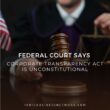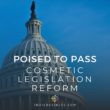When I was a cosmetics manufacturer years ago, I joined the Personal Care Products Council (formerly known as the Cosmetic, Toiletries & Fragrances Association). At the time, I lived in Washington, DC and I enjoyed going to their offices from time to time to use their library. I also learned a lot from them about how to run a successful cosmetics company under the authority of the Food & Drug Administration, which regulates cosmetics.
Today, the pending FDA Globalization Act of 2009 is poised to amend the cosmetics laws for the first time in decades. The pending legislation got me to thinking about an interesting quirk in the law the makes it difficult for startup and small and independent cosmetics companies to label their products in accordance with FDA law.
One of the documents I used most at the PCPC library was the “INCI Dictionary,” which contains the names required to be used to identify ingredients on cosmetic product labels. Then as now, only members or non-members who purchased the INCI Dictionary had access to it. As I recall, the price was somewhere around $400 and it was not available online. Today, the INCI Dictionary is available online from PCPC. The price is $995.00
What Are INCI Names?
INCI names are the names required by federal regulation to be used to identify the ingredients in a cosmetic, and must be listed in the ingredient declaration. The FDA established the requirement for cosmetic ingredient declarations on product labeling under the authority of Section 5 of the Fair Packaging and Labeling Act (FPLA) (21 CFR 701.3).
The FPLA provides authority to promulgate regulations “necessary to prevent the deception of consumers or to facilitate value comparisons.” To accomplish these goals, the regulation requires that cosmetic product labels be prominent and conspicuous so they are “likely to be read and understood by ordinary individuals under normal conditions of purchase…”
(21 CFR 701.3(b)). Further, Section 5(c)(3)(B) requires the use of “the common or usual name” for identification of each such ingredient included in the preparation.
In other words, the same names — INCI names — must be used on all products to ensure that cosmetic ingredients are consistently identified and consumers can readily compare ingredients when making purchasing decisions.
The specific section of the regulations that says the INCI names must be used is Title 21, Section 701.3 of the Food Drug & Cosmetic Act. You can find the entire section here, but the critical language where INCI is concerned is that, if the FDA does not specifically say which name should be used to identify an ingredient (and it does so only rarely), then name adopted for that ingredient in the PCPC dictionary — the INCI name — is to be used. (Note: PCPC is identified as CTFA, the former name of the PCPC.)
And where is this dictionary available? It's available from PCPC's PCPC website. Members can subscribe (PDF) to the online version of the Web Based International Cosmetics Ingredient Dictionary & Handbook for an annual fee of o $495. Non-members must pay $995. The hard copy version of the Dictionary is also available for $495.00 (PCPC members) or $795 (non members)
What’s A Small Business To Do?
This presents an obvious challenge for small businesses. They either have to join PCPC (PDF) at a minimum annual price of $640, and then purchase the INCI information for a minimum of $495, or they have to purchase the information without joining for between $795 and $995.
It would be one thing if using INCI names was optional, but it's not. Requiring companies to pay a fee to a private non-profit entity in order to access information that is necessary (not optional) in order to comply with the law amounts to a barrier to entry into the cosmetics arena. Small businesses have adapted by getting the INCI information from second-hand sources. That is, people purchase the information from PCPC and then share it with others. This behavior obviously solves the small manufacturer’s labeling problem, but only to the extent they can trust the second hand source. (Of course, the fact that the INCI dictionary bears the PCPC copyright ownership notice is another issue altogether.)
The bottom line? The mandatory nature of the labeling rules forces small businesses to either rely on second hand information to comply with the law, or spend $1,000 a year to comply with federal labeling laws.
What Should Happen?
I am not sure, but I do not believe the current situation was the intent of Congress, the FDA or the PCPC. After all, the current regulatory structure was implemented at a time when only large companies made cosmetics. For them, $1,000 for a labeling manual was and still is a drop in the bucket.
At the leader of a 800+ member trade organization that serves the cosmetics industry, I know that there are thousands of tiny new entrants bringing massive amounts of innovation and energy to the industry. To me, it seems clearly unduly burdensome for these small companies to have to pay $1,000 to gain access to information that is required by law to be included on their product labels.
I think it’s time for Congress and/or the FDA to act, in particular while it is considering new legislation anyway, to create a level playing field that enables all companies, large and small, to have unencumbered access to the information needed to label their cosmetics in compliance with the law.
I will continue to monitor issues of interest as they impact progress on the FDA Globalization Act of 2009 and the Safe Baby Products Act, and report relevant information here.
Question: What do you think? Do you think it’s time for INCI names to be made public so all can see and have unfettered access to them? Post your thoughts and opinions in the comments section below.



